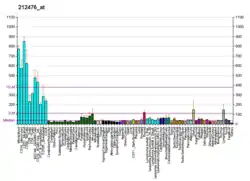| ACAP2 | |||||||||||||||||||||||||||||||||||||||||||||||||||
|---|---|---|---|---|---|---|---|---|---|---|---|---|---|---|---|---|---|---|---|---|---|---|---|---|---|---|---|---|---|---|---|---|---|---|---|---|---|---|---|---|---|---|---|---|---|---|---|---|---|---|---|
| Identifiers | |||||||||||||||||||||||||||||||||||||||||||||||||||
| Aliases | ACAP2, CENTB2, CNT-B2, ArfGAP with coiled-coil, ankyrin repeat and PH domains 2 | ||||||||||||||||||||||||||||||||||||||||||||||||||
| External IDs | OMIM: 607766 MGI: 1925868 HomoloGene: 8182 GeneCards: ACAP2 | ||||||||||||||||||||||||||||||||||||||||||||||||||
| |||||||||||||||||||||||||||||||||||||||||||||||||||
| |||||||||||||||||||||||||||||||||||||||||||||||||||
| |||||||||||||||||||||||||||||||||||||||||||||||||||
| |||||||||||||||||||||||||||||||||||||||||||||||||||
| |||||||||||||||||||||||||||||||||||||||||||||||||||
| Wikidata | |||||||||||||||||||||||||||||||||||||||||||||||||||
| |||||||||||||||||||||||||||||||||||||||||||||||||||
Arf-GAP with coiled-coil, ANK repeat and PH domain-containing protein 2 is a protein that in humans is encoded by the ACAP2 gene.[5][6][7]
References
- 1 2 3 GRCh38: Ensembl release 89: ENSG00000114331 - Ensembl, May 2017
- 1 2 3 GRCm38: Ensembl release 89: ENSMUSG00000049076 - Ensembl, May 2017
- ↑ "Human PubMed Reference:". National Center for Biotechnology Information, U.S. National Library of Medicine.
- ↑ "Mouse PubMed Reference:". National Center for Biotechnology Information, U.S. National Library of Medicine.
- ↑ Jackson TR, Kearns BG, Theibert AB (Dec 2000). "Cytohesins and centaurins: mediators of PI 3-kinase-regulated Arf signaling". Trends Biochem Sci. 25 (10): 489–95. doi:10.1016/S0968-0004(00)01644-3. PMID 11050434.
- ↑ Jackson TR, Brown FD, Nie Z, Miura K, Foroni L, Sun J, Hsu VW, Donaldson JG, Randazzo PA (Nov 2000). "ACAPs are arf6 GTPase-activating proteins that function in the cell periphery". J Cell Biol. 151 (3): 627–38. doi:10.1083/jcb.151.3.627. PMC 2185579. PMID 11062263.
- ↑ "Entrez Gene: CENTB2 centaurin, beta 2".
Further reading
- Nomura N, Nagase T, Miyajima N, et al. (1995). "Prediction of the coding sequences of unidentified human genes. II. The coding sequences of 40 new genes (KIAA0041-KIAA0080) deduced by analysis of cDNA clones from human cell line KG-1". DNA Res. 1 (5): 223–9. doi:10.1093/dnares/1.5.223. PMID 7584044.
- Maruyama K, Sugano S (1994). "Oligo-capping: a simple method to replace the cap structure of eukaryotic mRNAs with oligoribonucleotides". Gene. 138 (1–2): 171–4. doi:10.1016/0378-1119(94)90802-8. PMID 8125298.
- Suzuki Y, Yoshitomo-Nakagawa K, Maruyama K, et al. (1997). "Construction and characterization of a full length-enriched and a 5'-end-enriched cDNA library". Gene. 200 (1–2): 149–56. doi:10.1016/S0378-1119(97)00411-3. PMID 9373149.
- Dowler S, Currie RA, Campbell DG, et al. (2001). "Identification of pleckstrin-homology-domain-containing proteins with novel phosphoinositide-binding specificities". Biochem. J. 351 (Pt 1): 19–31. doi:10.1042/0264-6021:3510019. PMC 1221362. PMID 11001876.
- Strausberg RL, Feingold EA, Grouse LH, et al. (2003). "Generation and initial analysis of more than 15,000 full-length human and mouse cDNA sequences". Proc. Natl. Acad. Sci. U.S.A. 99 (26): 16899–903. Bibcode:2002PNAS...9916899M. doi:10.1073/pnas.242603899. PMC 139241. PMID 12477932.
- Gerhard DS, Wagner L, Feingold EA, et al. (2004). "The status, quality, and expansion of the NIH full-length cDNA project: the Mammalian Gene Collection (MGC)". Genome Res. 14 (10B): 2121–7. doi:10.1101/gr.2596504. PMC 528928. PMID 15489334.
- Rush J, Moritz A, Lee KA, et al. (2005). "Immunoaffinity profiling of tyrosine phosphorylation in cancer cells". Nat. Biotechnol. 23 (1): 94–101. doi:10.1038/nbt1046. PMID 15592455. S2CID 7200157.
External links
- Human ACAP2 genome location and ACAP2 gene details page in the UCSC Genome Browser.
This article is issued from Wikipedia. The text is licensed under Creative Commons - Attribution - Sharealike. Additional terms may apply for the media files.




